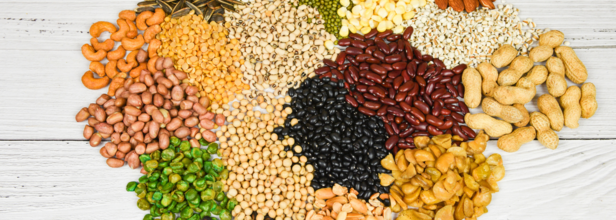- Health Conditions A-Z
- Health & Wellness
- Nutrition
- Fitness
- Health News
- Ayurveda
- Videos
- Medicine A-Z
- Parenting
- Web Stories
Are Whole Grains Really The Healthier Option?

Credits: Canva
Grains are the edible, dry seeds of grasses grown for food. Each whole grain kernel consists of three components, which are bran, germ and endosperm. The bran is the hard outer coating rich in fiber, antioxidants, and B vitamins. The germ is the small core that contains healthy fats, vitamins, and minerals. Whereas, the endosperm is the large, starchy middle layer, which provides carbohydrates but fewer nutrients.
When whole grains are processed to create refined grains like the white flour or the white rice, the bran and germ are removed. It only leaves the endosperm behind. This process then strips away much of the fiber, protein, and all other essential nutrients, that then results into a softer texture and milder flavor.
What Are The Health Benefits Of Whole Grains?
Whole grains have many benefits and are packed with nutrients. They support the body's overall health. They are rich in fiber, which means they help with digestion, support gut bacteria, and are also helpful in regulating bowel movements. Whole grains are also known to control blood sugar levels. This is because fiber slows digestion and improves insulin sensitivity and reduces the risk of diabetes. In terms of heart health, whole grains contain phytonutrients that can help reduce inflammation and lower the risk of heart disease. Lastly, it can also help with weight management, as high fiber content promotes satiety and helps with appetite control.
Are There Any Risks Of A Diet High In Refined Grains?
Refined grains, while not inherently harmful, can pose health risks when consumed in excess, including:
Low Fiber Intake: The removal of fiber leads to poor digestion and potential blood sugar spikes.
Highly Processed Additives: Many refined grain products, like pastries and white bread, contain added sugars, unhealthy fats, and sodium.
Increased Inflammation: Diets rich in processed grains may contribute to gut health issues and systemic inflammation.
So, what should you do, should you avoid refined grains completely?
Refined grains have been unfairly demonized, especially in the age of low-carb dieting. However, they are an important part of many cultural cuisines, such as sushi rice in Japan or French baguettes. Nutrition experts also emphasizes that balance is key. Thus, a healthy diet includes more whole grains than refined ones, along with plenty of fruits, vegetables, and protein sources.
How to Identify Whole Grain Products
When shopping for grain products, don’t be misled by labels like “multigrain” or “made with whole grains.” Instead, check for these indicators:
Ingredients List: Look for “whole wheat” or “100% whole grain” as the first ingredient.
Fiber Content: A true whole grain product should have at least 3g of fiber per serving.
Unprocessed Options: Consider whole grains like quinoa, farro, oats, and brown or black rice for maximum health benefits.
Whole grains offer undeniable health advantages, but refined grains need not be avoided entirely. The key to a healthy diet lies in balance, accessibility, and overall lifestyle. Rather than focusing on individual food choices, consider broader dietary patterns, portion sizes, and physical activity. By making informed choices, you can enjoy a nutritious diet without unnecessary restrictions.
Harvard Gut Doctor Shares Top 3 'Science-Backed' Foods That Reduce Liver Fat

The cleaning crew of our body, which is responsible for making sure we are clear of all toxins, which is also responsible for metabolizing all your food, liver, often gets ignored. Although we eat foods that help us support our gut health, our brain health, even our reproduction health, during all this, we can end up overlooking the second largest organ in our body.
However, why do we need to be careful with our liver’s health?
Why Your Liver Is So Important
You might not think about your liver much, but if it stopped working, your health would be in serious trouble. Your liver is a vital organ with many critical jobs, like filtering toxins, helping you digest food, and processing medications.
When the liver is damaged, it can develop a condition called cirrhosis, where healthy liver cells are replaced by scar tissue. Another growing problem is nonalcoholic fatty liver disease, which is common in people who are obese and can also lead to cirrhosis. If your liver fails, toxins will build up in your body, you won't be able to digest your food properly, and medicines won't work as they should.
To avoid these serious health issues, it's essential to take care of your liver. Dr. Saurabh Sethi, gastroenterologist trained at AIIMS, Harvard, and Stanford Universities, gave us three things to keep in our diet to help us support our liver health.
What Foods Support Our Liver Health?
According to Dr. Sethi, one of the easiest ways to start taking care of your liver is by changing what you drink. He suggests a few healthy options that you can easily add to your daily routine.
Healthy Drinks
Drinks like black coffee, black tea, green tea, and matcha are all great choices. They contain special compounds that help support your liver and keep your body's metabolism working properly. So, swapping out a sugary drink for one of these can make a big difference.
Turmeric
The second food Dr. Sethi recommends is turmeric. This bright yellow spice isn't just for adding flavor to your food—it's also great for your health. Turmeric contains a powerful ingredient called curcumin, which is known for its strong ability to fight inflammation. Inflammation can be very damaging to the liver, so by including just a small amount of turmeric in your diet—about half to one teaspoon a day—you can help protect and support your liver's health.
Berries, Broccoli, and Beets
Dr. Sethi groups these three foods together because they are all essential for a healthy liver. He calls them the "three Bs."
- Berries are full of antioxidants, which are like tiny bodyguards that protect your liver from damage.
- Broccoli is a type of vegetable that's high in fiber. It also contains a special compound called sulforaphane, which helps your liver get rid of harmful toxins more effectively.
- Beets (or beetroot) are known for their high content of beta-lanes, which are powerful anti-inflammatory and antioxidant agents. They help improve blood flow to the liver and support its natural ability to detoxify your body.
By adding these three simple foods to your meals, you can give your liver the extra support it needs to stay healthy.
Can Food Really Boost Fertility? Nutritionist Shares What To Eat When You Are Trying To Conceive

Credits: Canva
When couples decide they’re ready to start a family, the focus often shifts to medical tests, ovulation tracking, and lifestyle changes but what if the way to parenthood began not in a clinic but in your kitchen? Something many overlook, what’s on your plate might be just as important as what’s your schedule. Fertility isn’t only about biology; it’s also about nourishment. The right foods can influence hormone balance, improve egg and sperm quality, and create a healthier environment for conception. So before you rush into supplements or stressful routines, it’s worth asking: could your daily meals be quietly shaping your chances of conceiving?
For many couples who are struggling to conceive, this quest feels both hopeful and overwhelming. While modern medicine acknowledges fertility treatments like IVF and IUI, it often falls short of offering solutions for couples trying naturally. That gap is where your diet and traditional approaches like Ayurveda can possibly step in. From Harvard’s recent review on fertility nutrition to ancient Ayurvedic practices, food is increasingly being recognized as a powerful ally in conception.
How Is Diet And Fertility Connected?
A sweeping review from the Harvard T.H. Chan School of Public Health and Harvard Medical School examined dozens of studies exploring diet and fertility. Their findings underline what many nutritionists have long suggested: what you eat can influence how quickly—or whether—you conceive.
For women, diets rich in folic acid, vitamin B12, and omega-3 fatty acids were linked to improved fertility outcomes. The Mediterranean diet, known for its vegetables, legumes, lean proteins, and olive oil, also appeared beneficial. In contrast, diets heavy in trans fats, red and processed meats, sugary drinks, and fast foods correlated with longer times to pregnancy and reduced fertility.
For men, the story was similar. Healthy diets improved semen quality, while high intake of saturated and trans fats had the opposite effect. While semen quality isn’t the perfect marker for male fertility, the evidence points toward lifestyle choices influencing reproductive health.
Interestingly, the study found little effect—positive or negative—from antioxidants, vitamin D, dairy, soy, caffeine, or alcohol when it came to fertility outcomes. That doesn’t mean these foods are irrelevant, but the strongest signals came from folate, B12, omega-3s, and an overall nutrient-dense dietary pattern.
How Can An Ayurvedic Diet Boost Fertility?
Celebrity Ayurvedic Nutritionist Shweta Shah explains that Ayurveda views fertility not just as a physical process but as an indicator of overall vitality. At its core lies ojas, described as the essence of health and immunity. “For conception to occur, ojas must be strong, digestion (agni) steady, and the doshas balanced,” she says.
One traditional ritual Shah recommends is a warm saffron-cardamom milk tonic, ideally consumed in the evening. The tonic combines saffron’s hormone-balancing and mood-stabilizing properties with cardamom’s ability to enhance circulation and nutrient delivery to reproductive tissues. “Warm milk nourishes shukra dhatu, the reproductive tissue supporting egg health and vitality,” Shah adds. Taken regularly, the tonic is said to build ojas, improve sleep, and even enhance desire, creating harmony in the reproductive system.
What to Add To Your Fertility Plate: What to Eat, What to Limit
Both modern nutrition and Ayurveda agree on one key point: fertility thrives on balance.
Foods to embrace include cooked whole grains, legumes, leafy vegetables, healthy fats like ghee, sesame oil, soaked nuts, and omega-rich seeds such as flax and chia. In Ayurveda, warm, cooked meals are emphasized to support digestion and nutrient absorption.
Spices like cumin, fennel, turmeric, and cinnamon are not just flavor enhancers; they improve circulation and balance hormones. Herbs such as ashwagandha and shatavari are often recommended for reproductive support.
What to avoid: Refined sugar, excess caffeine, alcohol, irregular eating patterns, and overexertion. Shah explains, “These deplete ojas, disturb digestion, and create imbalance in the body.”
Why Lifestyle Is The Missing Piece in Fertility Conversations?
Diet alone cannot guarantee conception. Both research and Ayurveda highlight lifestyle factors—sleep, stress, and physical activity—as critical players in fertility. The Harvard review pointed out that women who consumed more fast food and fewer fruits took longer to conceive, while those who included more seafood in their diet got pregnant faster. Similarly, Ayurveda stresses mindful living, gentle movement, self-care rituals like abhyanga (warm oil massage), and emotional connection.
Shah puts it simply, “Conception is not just reproduction—it’s a sacred invitation. It requires nourishment, balance, and an environment of emotional safety.”
So, can food really boost your chances of pregnancy? The evidence suggests it can certainly help—but it’s not a magic bullet. Fertility is influenced by a tapestry of factors, from age and genetics to environmental exposures. What diet can do is optimize the conditions for conception, supporting both egg and sperm health, and preparing the body for a healthy pregnancy.
As Shah reminds us, “When we align with nature—through what we eat, how we live, and how we connect emotionally—we create the most fertile ground for life to flourish.”
Nutritionist Explains The 5 Evening Habits That Help You Wake Up Energized

Credits: Health and me
What’s the first thing you feel when you wake up in the morning light and energized, or heavy and sluggish? For many people, the answer has less to do with how many hours they slept and more with what they ate the night before. Nutritionists say your dinner choices can set the tone for your digestion, sleep quality, and even your morning energy levels. The question you should ask yourself is, are your nighttime eating schedule working for you or against you?
The answer may not lie in a new mattress, a sleep app, or even a strict bedtime routine—it could be sitting right on the dinner table. Sleep specialists and nutritionists agree that the way we eat in the evening plays a powerful role in how well we rest and how efficiently our bodies recover overnight.
With nearly one-third of US adults routinely falling short on sleep, according to the Centers for Disease Control and Prevention (CDC), understanding the connection between food and sleep quality has become more than a lifestyle trend, it’s a public health concern. From nutrient timing to mindful eating, science increasingly points to a two-way relationship: just as sleep influences hunger and metabolism, nutrition can either sabotage or support deep, restorative rest.
Overlooked Link Between Nutrition and Sleep
Research shows that diets high in sugar, saturated fat, and processed foods are consistently linked to restless or fragmented sleep. Meanwhile, balanced diets rich in fiber, lean protein, and complex carbohydrates appear to promote more consistent and restorative sleep cycles. Even the timing of dinner matters. Late-night eating, particularly heavy meals, forces the digestive system to stay active at a time when it should be winding down, often leading to indigestion, reflux, or interrupted sleep.
“Your last meal of the day can play a powerful role in how well your body digests food and how deeply you sleep,” says clinical nutritionist Prachi Mandholia. “When dinner is timed and balanced correctly, it allows the body to rest and repair overnight instead of being overworked.”
Can Eating Dinner Early Helps the Body Reset?
One of the simplest yet most effective changes is to finish dinner two to three hours before bedtime. Research has long suggested that late-night eating is associated with a higher risk of gastroesophageal reflux disease (GERD) and disrupted sleep cycles.
“An early, lighter meal gives your body time to process food calmly,” explains Mandholia. “This reduces the likelihood of acidity, bloating, or heaviness, all of which can make falling asleep and staying asleep more difficult.”
For those accustomed to late dinners due to work or social commitments, shifting mealtimes even slightly earlier can help. Experts recommend pairing this with smaller, nutrient-dense evening meals rather than heavy, multi-course spreads.
Why It Is Important to Build a Balanced Dinner Plate?
Nutritionists emphasize that not just timing, but composition matters. Heavy, greasy, or overly spicy foods tend to delay digestion and disturb sleep. Instead, a dinner plate that includes seasonal vegetables, lean proteins such as fish or legumes, and complex carbohydrates like quinoa, brown rice, or millets provides both satiety and stability.
This combination ensures a steady release of energy overnight, which prevents sudden spikes or drops in blood sugar—a common cause of nighttime wakefulness. A balanced meal also keeps the digestive system from becoming overloaded, allowing the body to direct more energy toward repair and recovery during sleep.
What Role Do Sleep-Friendly Foods Play?
Certain foods contain nutrients that can directly influence the body’s ability to relax. Tryptophan, an amino acid found in foods like turkey, nuts, and seeds, helps boost serotonin and melatonin levels—two hormones critical for sleep regulation. Magnesium, present in almonds and pumpkin seeds, relaxes the nervous system, while melatonin-rich foods like cherries may naturally encourage drowsiness.
“Adding a small handful of almonds, walnuts, or pumpkin seeds to your evening routine can prepare your body for rest,” notes Mandholia. Importantly, these are not meant as large bedtime snacks but as thoughtful additions to an early evening meal.
Mindful Eating Over Mindless Habits
What we eat is only half of the equation—how we eat matters too. Eating in front of the television, scrolling through social media, or rushing through a meal often leads to overeating and indigestion. Studies on mindful eating show that slowing down, chewing thoroughly, and paying attention to flavors improves digestion and helps the body recognize satiety cues.
“Mindful eating improves digestion, prevents overeating, and allows you to feel satisfied at the right time,” says Mandholia. The practice also creates a calming pre-sleep ritual, lowering stress and signaling to the body that it’s time to wind down.
Hydration is Important But at the Right Time
Hydration is essential for overall health, but drinking large amounts of fluids too close to bedtime can disrupt sleep by causing frequent nighttime bathroom trips. Instead, experts recommend prioritizing water intake earlier in the day and tapering off by evening. If you’re prone to dry mouth or dehydration at night, a small sip of water before bed is usually sufficient without interrupting rest.
The effects of nighttime eating habits extend beyond one night of rest. Poor sleep, fueled by heavy or late dinners, can increase cravings for sugary and fatty foods the next day, perpetuating a cycle of poor nutrition and sleep deprivation. Over time, this cycle may raise the risk of obesity, type 2 diabetes, and cardiovascular disease.
On the other hand, cultivating evening habits that support digestion and sleep creates a positive feedback loop. A well-rested body regulates appetite better, digests food more efficiently, and is less likely to store excess energy as fat.
As Mandholia puts it, “A restful night truly begins on your dinner plate.” Simple shifts like eating earlier, choosing balanced meals, including sleep-friendly foods, practicing mindful eating, and hydrating smartly, can transform not just how we sleep, but how we feel when we wake.
© 2024 Bennett, Coleman & Company Limited

